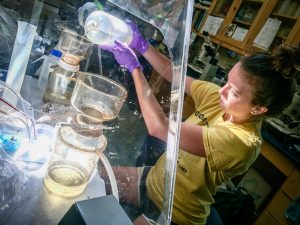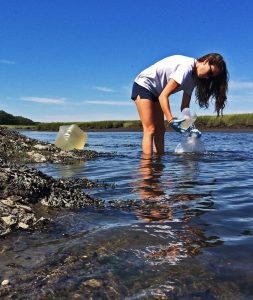 The element mercury (Hg) enters the environment by natural and human sources, transforms in complex ways, and often ends up in the fish we eat. Mercury can be methylated (addition of a CH3 group) in the environment to form methylmercury, which builds up in fish tissues and can reach high concentrations in large fish. This is a concern because methylmercury is a toxin which can lead to negative neurological, developmental, and even cardiovascular effects. Because of these impacts, it is important to understand how mercury and methylmercury cycle in the environment, so that ultimately, we can develop effective management techniques.
The element mercury (Hg) enters the environment by natural and human sources, transforms in complex ways, and often ends up in the fish we eat. Mercury can be methylated (addition of a CH3 group) in the environment to form methylmercury, which builds up in fish tissues and can reach high concentrations in large fish. This is a concern because methylmercury is a toxin which can lead to negative neurological, developmental, and even cardiovascular effects. Because of these impacts, it is important to understand how mercury and methylmercury cycle in the environment, so that ultimately, we can develop effective management techniques.
In a recent publication, Professor Robert Mason and former graduate student Dr. Emily Seelen (now a postdoctoral scholar at USC) investigated the differences in mercury cycling between contaminated and uncontaminated sites within 10 estuaries along the coast of the US Northeast. Contaminated sites are areas where mercury was directly released into waterways many years ago, usually as industrial waste. Uncontaminated sites contain less mercury, but it is still present in lower concentrations. Samples and measurements were taken throughout 2012-2016, which produced a data set containing mercury, methylmercury, and chemical and physical properties of the water and sediment. Watershed land use data was also applied. Seelen explains the data analysis, “We used different statistical approaches to look for trends between the variables. The main findings were derived from a multiple linear regression analysis, which we used to evaluate which variables best described the concentrations of mercury and methylmercury in surface waters.”
 “We found that historically contaminated sites retain and recycle their mercury, which makes external signals such as riverine input less detectable. The longevity of mercury in such systems suggests that remediation by removal of the contaminated sediments is key.” On the other hand, in uncontaminated estuaries, mercury likely enters from via runoff, and is then gradually buried into the sediment. In both cases, methylmercury does not seem to come from the sediment or runoff. “We therefore suggest that the concentration of methylmercury in surface waters is determined by the amount of mercury released into the estuarine system, whether that be from the watershed or the sediments.” Seelen explains.
“We found that historically contaminated sites retain and recycle their mercury, which makes external signals such as riverine input less detectable. The longevity of mercury in such systems suggests that remediation by removal of the contaminated sediments is key.” On the other hand, in uncontaminated estuaries, mercury likely enters from via runoff, and is then gradually buried into the sediment. In both cases, methylmercury does not seem to come from the sediment or runoff. “We therefore suggest that the concentration of methylmercury in surface waters is determined by the amount of mercury released into the estuarine system, whether that be from the watershed or the sediments.” Seelen explains.
These findings show that mercury cycling is very different in historically contaminated sites than uncontaminated sites. For uncontaminated sites, the mercury comes from the entire watershed, which does not leave us with an easy way to carry out remediation projects. Seelen states that ultimately, “to lower mercury concentrations in fish, we need to emit less mercury.” According to the EPA, present-day emissions come from a variety of sources including artisanal and small-scale gold mining, coal combustion, metal production, cement production, and many others. The path to regulating and decreasing these emissions begins with studies such as this one.
Citation:
Seelen, E. A., Chen, C. Y., Balcom, P. H., Buckman, K. L., Taylor, V. F., & Mason, R. P. (2021). Historic contamination alters mercury sources and cycling in temperate estuaries relative to uncontaminated sites. Water Research. DOI: 10.1016/j.watres.2020.116684